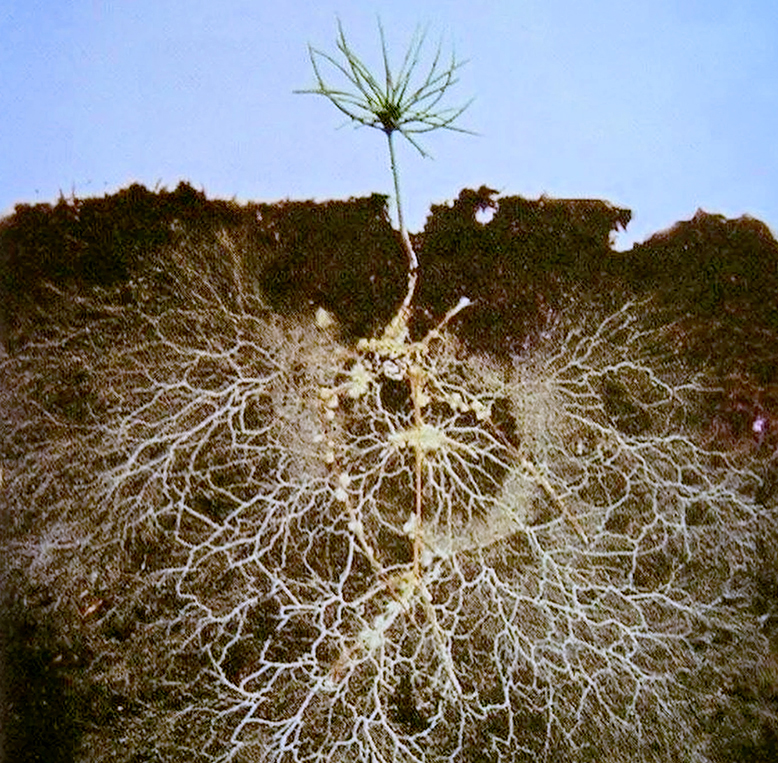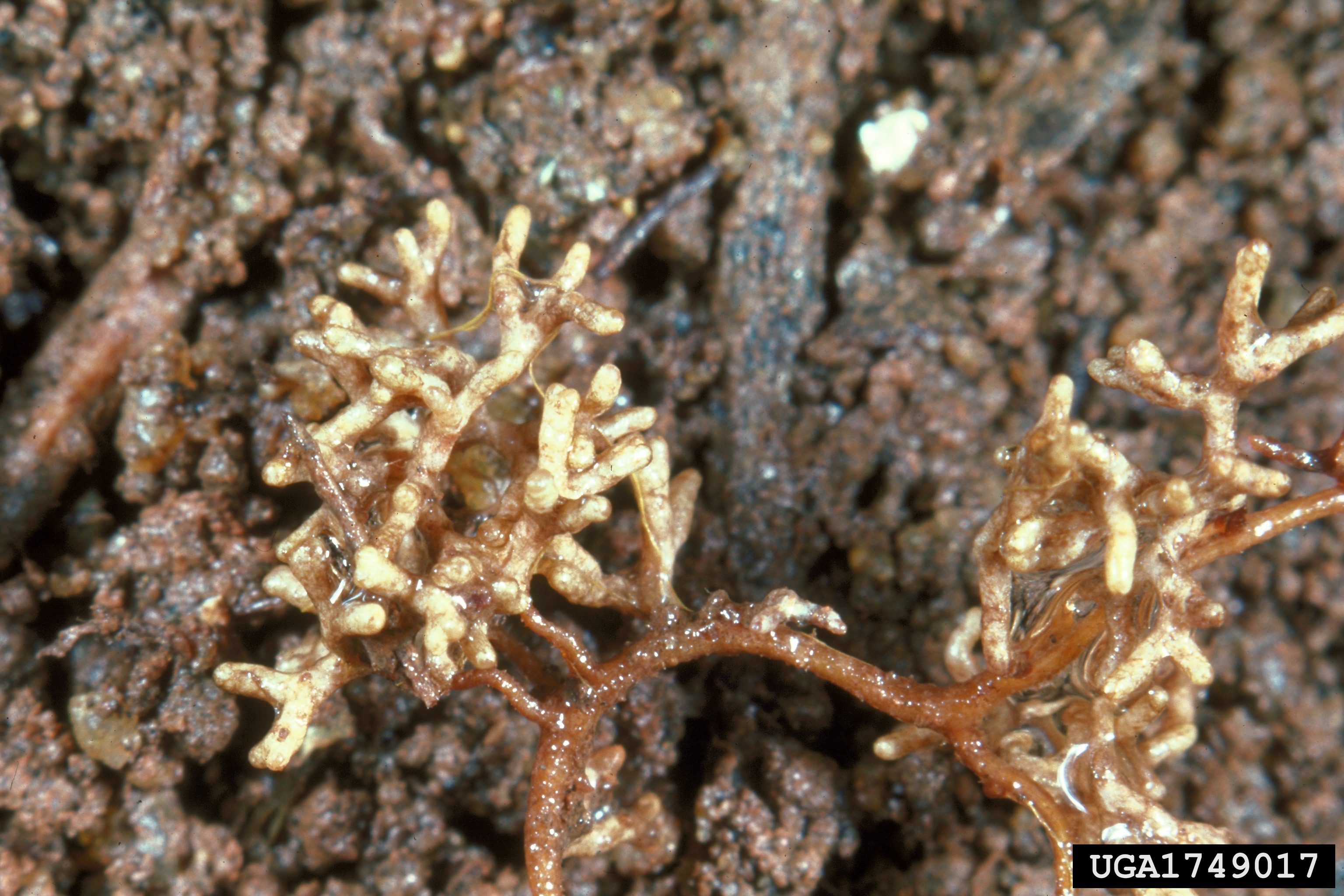 Microbial Activity in Soil - December 30, 2020 Jeff Schalau, Agent, Agriculture & Natural Resources University of Arizona Cooperative Extension, Yavapai County Healthy, native soils should contain a multitude of living organisms. Amended garden soils can be even richer in microorganisms. Most soil-borne organisms are microscopic. Of these, many are beneficial and help convert decaying organic matter into plant essential nutrients and humus. A teaspoonful of amended garden soil contains hundreds of millions to billions of individual microbes. It is difficult to imagine, but soil microbial biomass can range from several hundred to thousands of pounds per acre. By far, the most numerous microbes in soil are bacteria. They are free-living, single-celled organisms. Also abundant are fungi, some of which produce long, slender strings of cells called hyphae. Fungi also include yeasts and molds. The actinobacteria are an advanced group of bacteria that can form branches like fungi. Actinobacteria give soil its characteristic earthy smell. Fungi and actinobacteria are good at starting the decomposition of organic residues, breaking down materials that are more resistant to decomposition. Bacteria finish the job by consuming the more digestible ingredients and releasing essential plant nutrients and building blocks for future microbial generations. Many other microbes can be found in smaller numbers in soil, including algae, cyanobacteria (often called blue-green algae), and protozoa (one-celled organisms that decompose organic materials and consume bacteria). Nematodes are microscopic roundworms; some of these are beneficial and a few are plant parasites. As you might imagine, all these organisms combined create a complex food web in the soil. The soil zone located immediately around active roots is called the rhizosphere. This is an area of high microbial activity. Roots are not tightly sealed structures – they leak and in doing so release sugars and proteins (called exudates). This creates a food-rich environment for the growth of microorganisms. Rhizosphere microorganisms often form symbiotic relationships with plants which help plants access essential nutrients by dissolving soil minerals and decomposing organic matter. In some cases, they can also protect plant roots from pathogens. Some microbes have a specialized role in the rhizosphere. Rhizobia bacteria associate with the roots of legumes to form nodules. This symbiotic relationship provides the bacteria with a source of carbon (sugars) in exchange for making nitrogen available to the plant. Many gardeners are familiar with this process and encourage it by inoculating legume seeds with a commercial preparation of the Rhizobium species that is suited to the crop species they are planting. This practice increases soil nitrogen reserves and organic matter content. It is sometimes called “green manure”. A special group of fungi are called mycorrhizae and form symbiotic relationships with plant roots. By colonizing large areas of roots and reaching out into the soil, mycorrhizae aid in transfer of soil nutrients and water into the plant. The plant provides a source of carbon to the mycorrhizae. This is especially important in our native ecosystems where nutrient and moisture availability are limited. By the way, most soil scientists agree it is largely unnecessary to inoculate native soils with mycorrhizae and other microorganisms. Most soils already have resident populations that are well adapted to their local environment. Microbes promote good soil structure, which increases water infiltration and drainage, soil aeration, and vigorous root growth. Gummy substances produced by soil organisms (complex sugars and mucilage) also help soil particles adhere to each other, which contributes to soil structure. This also makes aggregates less likely to crumble when exposed to erosion by wind and water. Fungal hyphae further stabilize soil structure as their threadlike structures spread through the soil, surrounding particles and aggregates like a hairnet. Some soil microbes can cause plant diseases. In vegetable gardens, this often occurs when a certain type of crop is grown in the same space year after year. Crop rotation decreases the probability of soil-borne disease by varying the host plant species present in an area of soil. Disease causing organisms are also marginalized when beneficial microbes are occupying available niches in the rhizosphere. To encourage microbial activity in your garden, soil must be managed to create a favorable environment for both crops and microbes. This can be done by: minimizing tillage, avoiding soil compaction, using irrigation practices that keep the soil moist but not water-logged, and frequent additions of organic residues (i.e. compost) to provide energy for the microbes. This column was adapted from: Soil Microbiology: A Primer by Vern Grubinger, University of Vermont Extension Specialist. Additional information is available below. You can follow the Backyard Gardener on Twitter – use the link on the BYG website. If you have other gardening questions, email the Master Gardener Help Desk in Prescott (prescottmg@gmail.com) or Camp Verde (verdevalleymg@gmail.com) and be sure to include your name, location, and phone number. Find past Backyard Gardener columns or provide feedback at the Backyard Gardener web site: https://cals.arizona.edu/yavapai/anr/hort/byg/. Images  Pine seedling showing mycorrhizal roots (thick roots) and fungal mycelium (finer, threadlike material). The mycelium effectively increases the ability of roots to access nutrients such as phosphorus. The fungus benefits from the exchange by recieving carbohydrates from the pine tree. Photo from: California State University, Chico.
Pine seedling showing mycorrhizal roots (thick roots) and fungal mycelium (finer, threadlike material). The mycelium effectively increases the ability of roots to access nutrients such as phosphorus. The fungus benefits from the exchange by recieving carbohydrates from the pine tree. Photo from: California State University, Chico. Close up of mycorrhizal roots of a pine tree. Here the mycelium have been disturbed by excavation. In situ, they would look similar to the above photo. Photo from: Robert L. Anderson, USDA Forest Service, Bugwood.org.
Close up of mycorrhizal roots of a pine tree. Here the mycelium have been disturbed by excavation. In situ, they would look similar to the above photo. Photo from: Robert L. Anderson, USDA Forest Service, Bugwood.org.Additional Resources Soil Biology, University of Minnesota Extension extension.umn.edu/soil-management-and-health/soil-biologyr A Gardener’s Primer to Mycorrhizae: Understanding How They Work and Learning How to Protect Them, Washington State University Extension pubs.cahnrs.wsu.edu/publications/wp-content/uploads/sites/2/publications/FS269E.pdf How the Fungus Might Save Us, California Stae University, Chico www.csuchico.edu/regenerativeagriculture/blog/how-fungus-might-save-us.shtml |